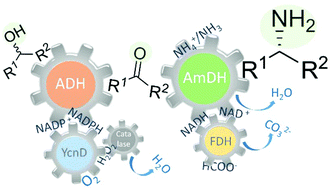当前位置:
X-MOL 学术
›
Org. Biomol. Chem.
›
论文详情
Our official English website, www.x-mol.net, welcomes your feedback! (Note: you will need to create a separate account there.)
In vitro biocatalytic pathway design: orthogonal network for the quantitative and stereospecific amination of alcohols
Organic & Biomolecular Chemistry ( IF 3.2 ) Pub Date : 2017-09-15 00:00:00 , DOI: 10.1039/c7ob01927k Tanja Knaus 1, 2, 3, 4 , Luca Cariati 1, 2, 3, 4 , Marcelo F. Masman 1, 2, 3, 4 , Francesco G. Mutti 1, 2, 3, 4
Organic & Biomolecular Chemistry ( IF 3.2 ) Pub Date : 2017-09-15 00:00:00 , DOI: 10.1039/c7ob01927k Tanja Knaus 1, 2, 3, 4 , Luca Cariati 1, 2, 3, 4 , Marcelo F. Masman 1, 2, 3, 4 , Francesco G. Mutti 1, 2, 3, 4
Affiliation

|
The direct and efficient conversion of alcohols into amines is a pivotal transformation in chemistry. Here, we present an artificial, oxidation–reduction, biocatalytic network that employs five enzymes (alcohol dehydrogenase, NADP-oxidase, catalase, amine dehydrogenase and formate dehydrogenase) in two concurrent and orthogonal cycles. The NADP-dependent oxidative cycle converts a diverse range of aromatic and aliphatic alcohol substrates to the carbonyl compound intermediates, whereas the NAD-dependent reductive aminating cycle generates the related amine products with >99% enantiomeric excess (R) and up to >99% conversion. The elevated conversions stem from the favorable thermodynamic equilibrium (K′eq = 1.88 × 1042 and 1.48 × 1041 for the amination of primary and secondary alcohols, respectively). This biocatalytic network possesses elevated atom efficiency, since the reaction buffer (ammonium formate) is both the aminating agent and the source of reducing equivalents. Additionally, only dioxygen is needed, whereas water and carbonate are the by-products. For the oxidative step, we have employed three variants of the NADP-dependent alcohol dehydrogenase from Thermoanaerobacter ethanolicus and we have elucidated the origin of the stereoselective properties of these variants with the aid of in silico computational models.
中文翻译:

体外生物催化途径设计:用于酒精定量和立体定向胺化的正交网络
醇直接有效转化为胺是化学中的关键性转变。在这里,我们介绍了一个人工的氧化还原生物催化网络,该网络在两个并发且正交的循环中使用了五种酶(酒精脱氢酶,NADP氧化酶,过氧化氢酶,胺脱氢酶和甲酸脱氢酶)。NADP依赖的氧化循环将多种芳香族和脂族醇底物转化为羰基化合物中间体,而NAD依赖的还原胺化循环产生相关的胺产物,其对映体过量(R)> 99%转换。升高的转化从有利热力学平衡杆(ķ '当量= 1.88×10 42 1.48×1041分别用于伯醇和仲醇的胺化)。该生物催化网络具有提高的原子效率,因为反应缓冲液(甲酸铵)既是胺化剂又是还原当量的来源。另外,仅需要双氧,而水和碳酸盐是副产物。对于氧化步骤,我们使用了乙醇嗜热厌氧菌NADP依赖性醇脱氢酶的三个变体,并借助计算机计算模型阐明了这些变体的立体选择性性质的起源。
更新日期:2017-09-22
中文翻译:

体外生物催化途径设计:用于酒精定量和立体定向胺化的正交网络
醇直接有效转化为胺是化学中的关键性转变。在这里,我们介绍了一个人工的氧化还原生物催化网络,该网络在两个并发且正交的循环中使用了五种酶(酒精脱氢酶,NADP氧化酶,过氧化氢酶,胺脱氢酶和甲酸脱氢酶)。NADP依赖的氧化循环将多种芳香族和脂族醇底物转化为羰基化合物中间体,而NAD依赖的还原胺化循环产生相关的胺产物,其对映体过量(R)> 99%转换。升高的转化从有利热力学平衡杆(ķ '当量= 1.88×10 42 1.48×1041分别用于伯醇和仲醇的胺化)。该生物催化网络具有提高的原子效率,因为反应缓冲液(甲酸铵)既是胺化剂又是还原当量的来源。另外,仅需要双氧,而水和碳酸盐是副产物。对于氧化步骤,我们使用了乙醇嗜热厌氧菌NADP依赖性醇脱氢酶的三个变体,并借助计算机计算模型阐明了这些变体的立体选择性性质的起源。



























 京公网安备 11010802027423号
京公网安备 11010802027423号